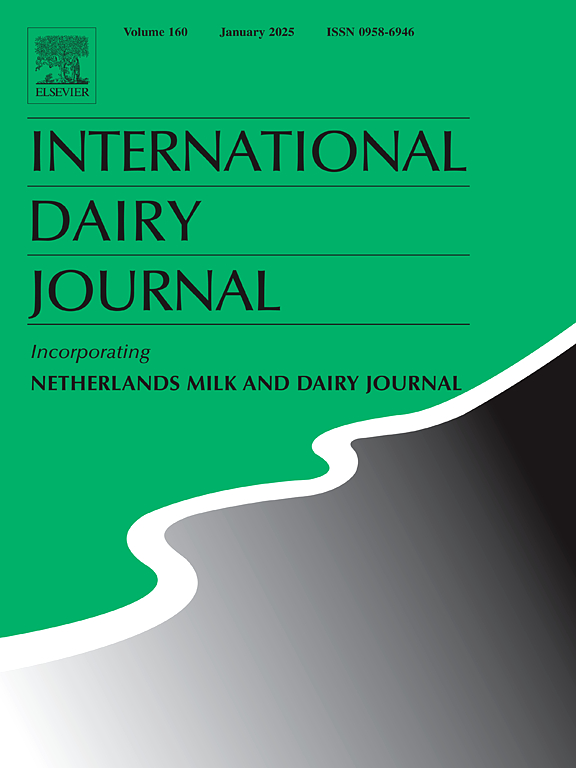Shiga toxin-producing Escherichia coli in the milk production chain: Evaluation of virulence genes and clonal diversity of O157:H7 strains
IF 3.1
3区 农林科学
Q2 FOOD SCIENCE & TECHNOLOGY
引用次数: 0
Abstract
Microbial contamination of milk and dairy products is a significant issue due to sensory changes and the risk of foodborne diseases. Shiga toxin-producing Escherichia coli (STEC), particularly the O157:H7, are major pathogens transmitted by dairy products. This study aimed to evaluate the microbiological quality of bovine milk at various stages of the production chain in a dairy cooperative and its suppliers in Rio de Janeiro, Brazil. Additionally, the presence of STEC in milk and faeces from dairy cattle was investigated, along with the isolation of STEC O157:H7 strains and the evaluation of virulence genes and clonal diversity. These findings were compared with previously isolated STEC O157:H7 strains from the same region. A total of 100 raw milk samples (54 farm gallon (FG) samples, 25 community bulk tank milk (CBTM) samples, 14 isothermal car-tanker milk (ICTM) samples, and 7 industry tank milk (ITM) samples) and 10 pasteurized milk samples, along with 63 bovine faeces samples, were analysed. The stx gene, a marker for STEC, was detected in 65% of raw milk samples and 88.9% of faecal samples, indicating a high risk of contamination throughout the production chain. None of the pasteurized milk samples tested positive for the stx gene. The prevalence of stx in faeces and raw milk underscores the need for rigorous controls to prevent contamination. While pasteurization was effective, the microbiological quality of raw milk remained unsatisfactory, highlighting the importance of good hygiene practices and continuous monitoring to ensure dairy safety.
牛奶生产链中产志贺毒素的大肠杆菌:评估 O157:H7 菌株的毒力基因和克隆多样性
由于感官变化和食源性疾病风险,牛奶和乳制品的微生物污染是一个重要问题。产志贺毒素大肠杆菌(STEC),尤其是 O157:H7,是乳制品传播的主要病原体。本研究旨在评估巴西里约热内卢一家乳制品合作社及其供应商的牛乳在生产链各阶段的微生物质量。此外,还调查了奶牛牛奶和粪便中 STEC 的存在情况,同时分离出 STEC O157:H7 菌株,并对毒力基因和克隆多样性进行了评估。这些结果与之前从同一地区分离出的 STEC O157:H7 菌株进行了比较。共分析了 100 个生乳样本(54 个农场加仑奶(FG)样本、25 个社区散装罐装奶(CBTM)样本、14 个等温罐装奶(ICTM)样本和 7 个工业罐装奶(ITM)样本)和 10 个巴氏杀菌奶样本,以及 63 个牛粪便样本。在 65% 的生奶样本和 88.9% 的粪便样本中检测到 STEC 的标记物 stx 基因,这表明整个生产链受到污染的风险很高。巴氏杀菌奶样本中没有一个检测出 STX 基因呈阳性。粪便和生奶中stx的流行强调了严格控制以防止污染的必要性。虽然巴氏杀菌法很有效,但原料奶的微生物质量仍然不尽如人意,这凸显了良好卫生习惯和持续监测对确保乳品安全的重要性。
本文章由计算机程序翻译,如有差异,请以英文原文为准。
求助全文
约1分钟内获得全文
求助全文
来源期刊

International Dairy Journal
工程技术-食品科技
CiteScore
6.50
自引率
9.70%
发文量
200
审稿时长
49 days
期刊介绍:
The International Dairy Journal publishes significant advancements in dairy science and technology in the form of research articles and critical reviews that are of relevance to the broader international dairy community. Within this scope, research on the science and technology of milk and dairy products and the nutritional and health aspects of dairy foods are included; the journal pays particular attention to applied research and its interface with the dairy industry.
The journal''s coverage includes the following, where directly applicable to dairy science and technology:
• Chemistry and physico-chemical properties of milk constituents
• Microbiology, food safety, enzymology, biotechnology
• Processing and engineering
• Emulsion science, food structure, and texture
• Raw material quality and effect on relevant products
• Flavour and off-flavour development
• Technological functionality and applications of dairy ingredients
• Sensory and consumer sciences
• Nutrition and substantiation of human health implications of milk components or dairy products
International Dairy Journal does not publish papers related to milk production, animal health and other aspects of on-farm milk production unless there is a clear relationship to dairy technology, human health or final product quality.
 求助内容:
求助内容: 应助结果提醒方式:
应助结果提醒方式:


